Lake Michigan: An Overview
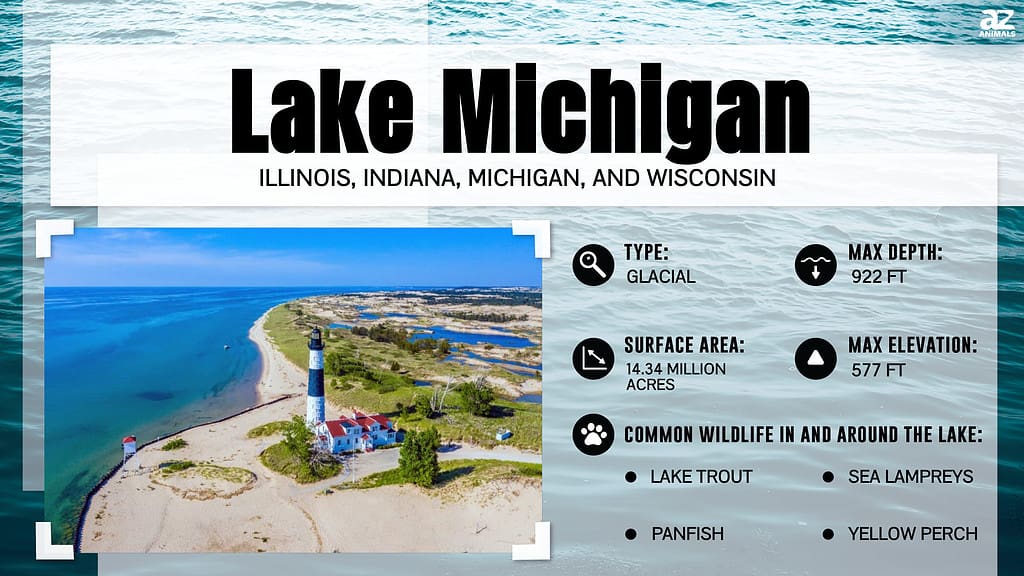
Lake Michigan is one of the five Great Lakes of North America and the only one located entirely within the United States. The other Great Lakes are Lake Superior, Lake Huron, Lake Erie, and Lake Ontario. It is the second-largest of the Great Lakes by volume and the third-largest by surface area, with Lake Superior and Lake Huron being larger.
Lake Michigan also has a rich and diverse history as substantial as its size (and it’s already pretty big) that dates back to the Native American tribes that inhabited its shores. It was a vital route for European exploration, trade, and warfare among the French, British, and American colonists.
Today, Lake Michigan is a popular destination for recreation, tourism, and commerce, with many cities, towns, and attractions along its coast. Let’s learn more about this incredible lake and its impact on the people, trade, and climate in the region.
Where is Lake Michigan Located on a Map?
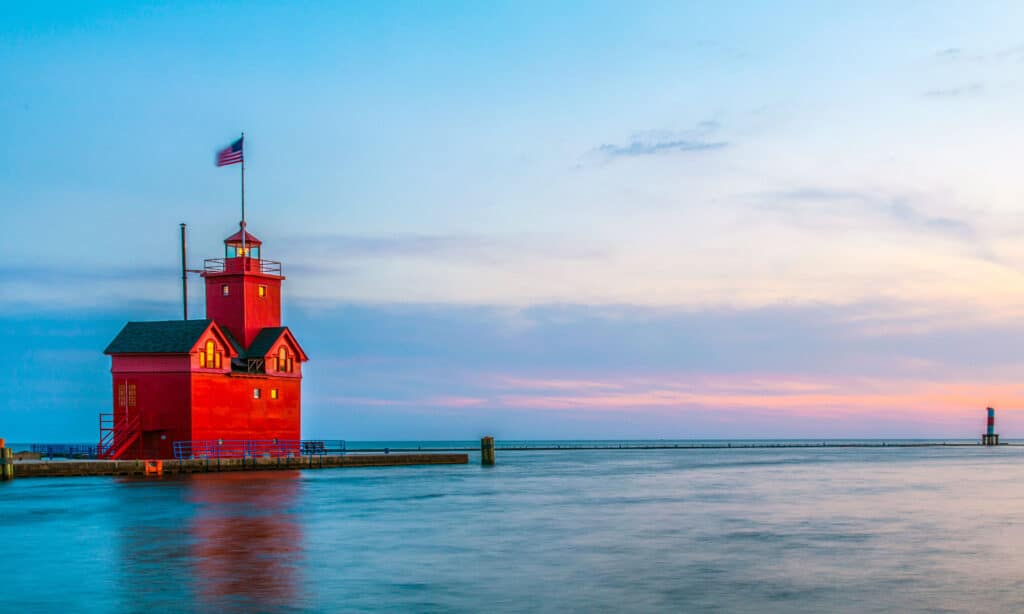
Lake Michigan is located in the northern Midwest United States and borders four states.
©Frederick Millett/Shutterstock.com
Lake Michigan borders the states of Michigan to the east and north, Wisconsin to the west, Illinois to the southwest, and Indiana to the southeast. It connects with Lake Huron through a strait to the north, meaning, technically, the two are a single lake. Lake Michigan is the world’s largest lake by area that is located fully in one country.
History
Lake Michigan has a long and rich history that spans from ancient geological timescales to the present day. The lake originally formed about 1.2 billion years ago when two tectonic plates pulled apart (creating something called a divergent boundary), creating the Mid-Continent Rift. Much later, the lake was inhabited by various Native American tribes, who called it “michi-gami” or “great water”. The first European to reach Lake Michigan was probably Jean Nicolet, a French explorer who was looking for a passage to Asia. He named the lake after the people who lived on its shores, the Puants or the Stinking Water. Later, the lake was claimed by France and then by the United States, the country that currently claims it.
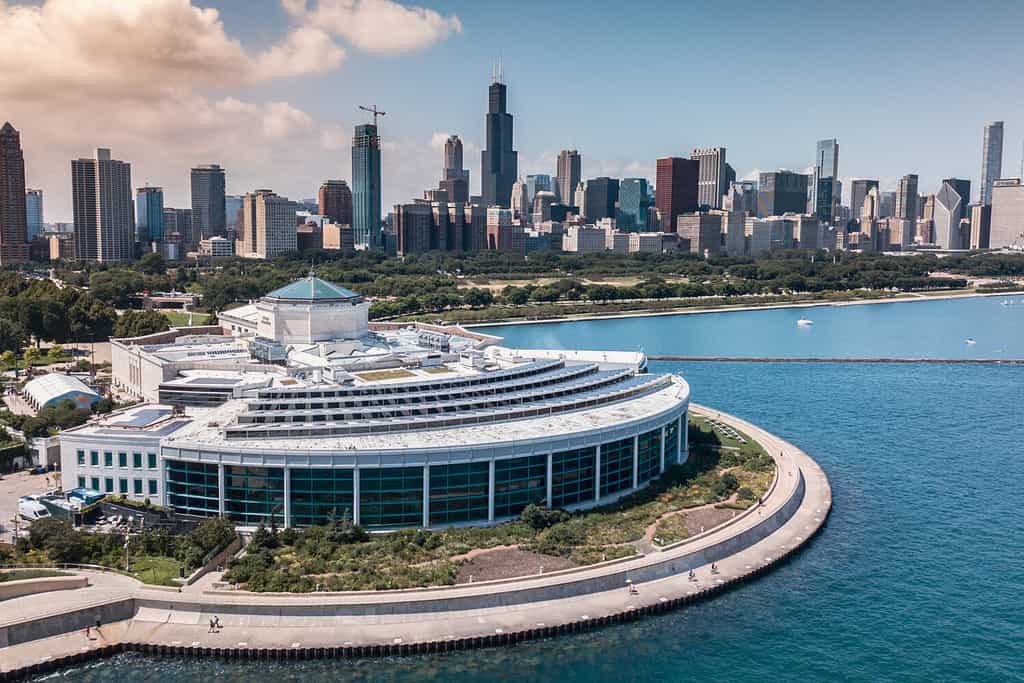
Formed over 1.2 billion years ago, Lake Michigan has been around longer than humans, although we have lived on its shores since the Native Americans.
©Robert Sarnowski/Shutterstock.com
Lake Michigan played an important role in the development of trade, transportation, and industry in the region. It was part of a waterway that connected the Atlantic Ocean with the Mississippi River and the Gulf of Mexico. French fur traders and missionaries used the lake to reach Native American villages and establish all sorts of settlements. Later, British and American colonists fought for control of the lake during the French and Indian War and the War of 1812. In the 19th and 20th centuries, Lake Michigan became a major hub for shipping, fishing, and tourism. The lake supported a massing fishery of lake trout, whitefish, perch, and salmon. With its combination of natural resources and industrial development, it’s no wonder that there are some extremely large cities along its borders, including Chicago, Milwaukee, and Green Bay.
Today, Lake Michigan is an important resource for millions of people who live near it. It provides water (some for drinking and some for crop irrigation), recreation, transportation, and a whole lot more. It is also home to many wildlife species of all sorts. From a legal perspective, it’s part of the Great Lakes system that Canada and the United States collectively administer through various agreements and organizations.
Size
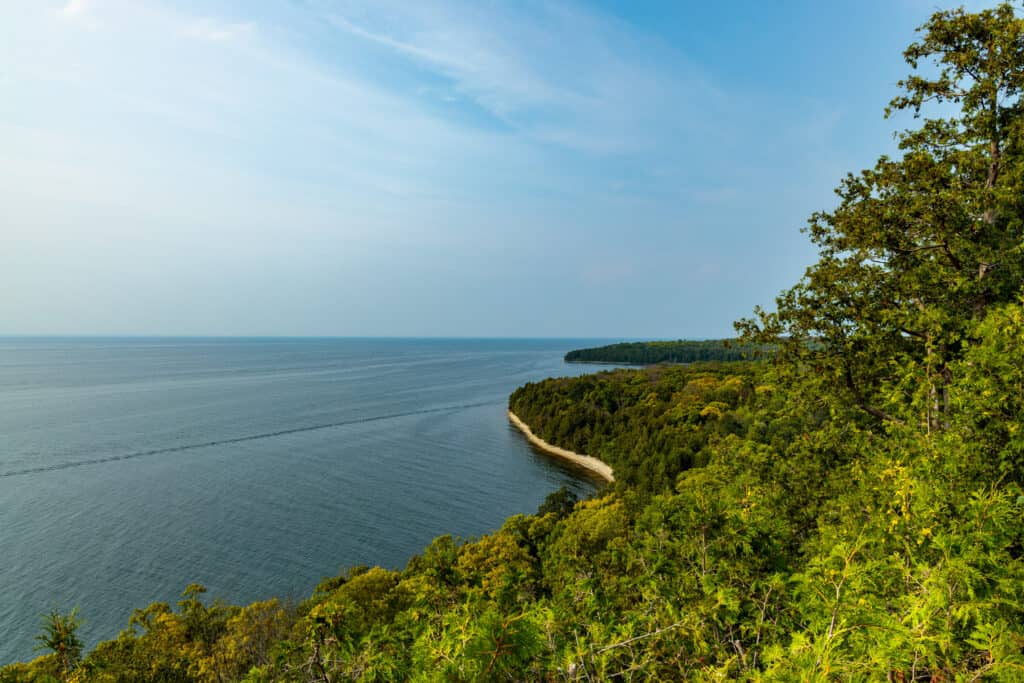
Lake Michigan is the third largest of the Great Lakes by surface area but the second largest in water volume.
©Sarah Michals/Shutterstock.com
Lake Michigan is a huge lake that covers a surface area of 22,404 square miles (58,030 square kilometers). That makes it the largest lake in the world that is in one country by surface area. It is also the fifth-largest lake in the world, and the fourth-largest freshwater lake in the world. The lake is 307 miles (494 kilometers) long from north to south and 118 miles (190 kilometers) wide from east to west. The lake has a shoreline length of 1,400 miles (2,300 kilometers), plus 238 miles (383 kilometers) for islands. The lake has an average depth of 279 feet (85 meters) and a maximum depth of 923 feet (281 meters). The lake holds a volume of 1,180 cubic miles (4,900 cubic kilometers) of water. Lake Michigan is connected to Lake Huron through the Straits of Mackinac, which are 3.5 miles (5.6 kilometers) wide and 295 feet (90 meters) deep. The two lakes are technically one lake with the same water level, although we usually treat them as separate in practice.
Depth
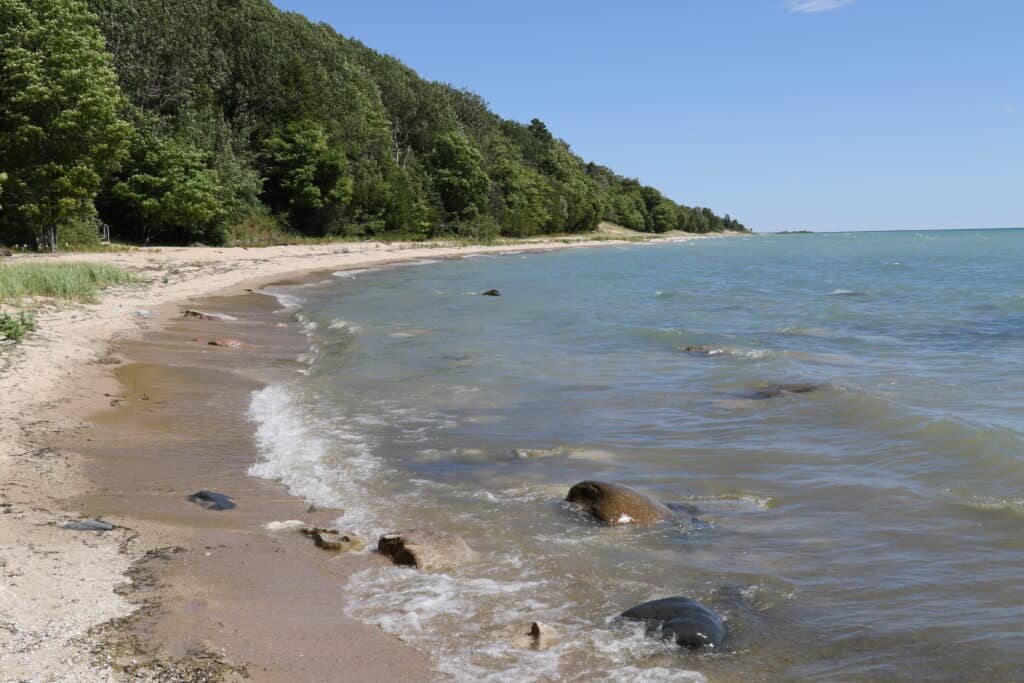
The average depth of Lake Michigan is 279 feet, and the deepest point is 923 feet.
©Thomas Barrat/Shutterstock.com
Lake Michigan is a deep lake that has an average depth of 279 feet (85 meters). That means it is deeper than Lake Erie, Lake Huron, and Lake Ontario but not as deep as Lake Superior. The lake has a maximum depth of 923 feet (281 meters), which is about the height of a 92-story building. The deepest point is marked with an “x” on something known as a “bathymetric map” of the lake. The lake holds a volume of 1,180 cubic miles (4,900 cubic kilometers) of water, which is more than the volume of Lake Erie and Lake Ontario combined. Lake Michigan is connected to Lake Huron through the Straits of Mackinac, which are 3.5 miles (5.6 kilometers) wide and 295 feet (90 meters) deep.
Water Level

The water level of Lake Michigan is somewhat variable and impacts the surrounding region.
©Kenneth Keifer/Shutterstock.com
Lake Michigan’s water level varies depending on several factors, such as precipitation, evaporation, runoff, ice cover, and human activities. The water level is measured by several stations around the lake operated by federal agencies. The lake’s water level is also forecasted by different models that consider the weather and climate conditions. The water level affects the lake’s ecosystem, shoreline, navigation, recreation, and economy since it is such an important resource for the region.
The water level of Lake Michigan has changed over time, from very low to very high levels, just like most other bodies of water. The lowest recorded water level was 576.02 feet (175.58 meters) above sea level in January 1964. The highest recorded water level was 582.35 feet (177.50 meters) above sea level in October 1986. Lake Michigan’s long-term average water level is 578.50 feet (176.25 meters) above sea level.
The water level of Lake Michigan is connected to the water level of Lake Huron through the Straits of Mackinac. Lake Michigan’s water level is also influenced by the water levels of Lake Superior, Lake Erie, and Lake Ontario through their connecting channels and outflows, but also because of the similarity of the surrounding region’s climate.
Fishing

Lake trout are some of the most important fish that live in Lake Michigan’s waters.
©Iryna Harry/Shutterstock.com
Lake Michigan is one of the best places in the world for anglers who love freshwater fishing. The lake offers a variety of fish species, fishing techniques, and fishing locations due to its size.
The lake is famous for its Salmon and Trout fishing, especially Steelhead, Coho Salmon, Chinook Salmon, Brown Trout, and Lake Trout. These fish were introduced to the lake in the 20th century to control an invasive fish called the Alewife. They thrived in the lake’s cold and deep waters and became a popular target for sportfishing as well as eating. You can generally fish for these species year-round, but the best time is from spring to fall when they migrate to shallower waters or enter tributary streams.
The lake also has other fish species that are native or naturalized, such as Perch, Walleye, Smallmouth Bass, Largemouth Bass, and Muskie. These fish are usually found in warmer and shallower waters near shorelines, reefs, islands, or river mouths. There are guides around the lake for anyone unfamiliar with the region looking to fish.
Geology

Lake Michigan was created through tectonic plates shifting and melting glaciers carving and filling it up.
©iStock.com/Focqus, LLC
Lake Michigan has a geology that reflects its long and complex history. The lake was formed about 1.2 billion years ago when two tectonic plates were pulled apart, creating the Mid-Continent Rift. This rift filled with sediments and lava flows over millions of years. The lake basin was further shaped by several cycles of glaciation and deglaciation during the Pleistocene epoch (a period commonly known as the Ice Age), which ended about 10,000 years ago. The glaciers carved out the lake basin, deposited soil, rock, and sediment onto outwash plains, and created tons of natural features such as islands, bays, sand dunes, and beaches.
Lake Michigan is also closely related to the other surrounding lakes from a geological standpoint, especially Huron since they are connected and geologically considered one lake.
Boating
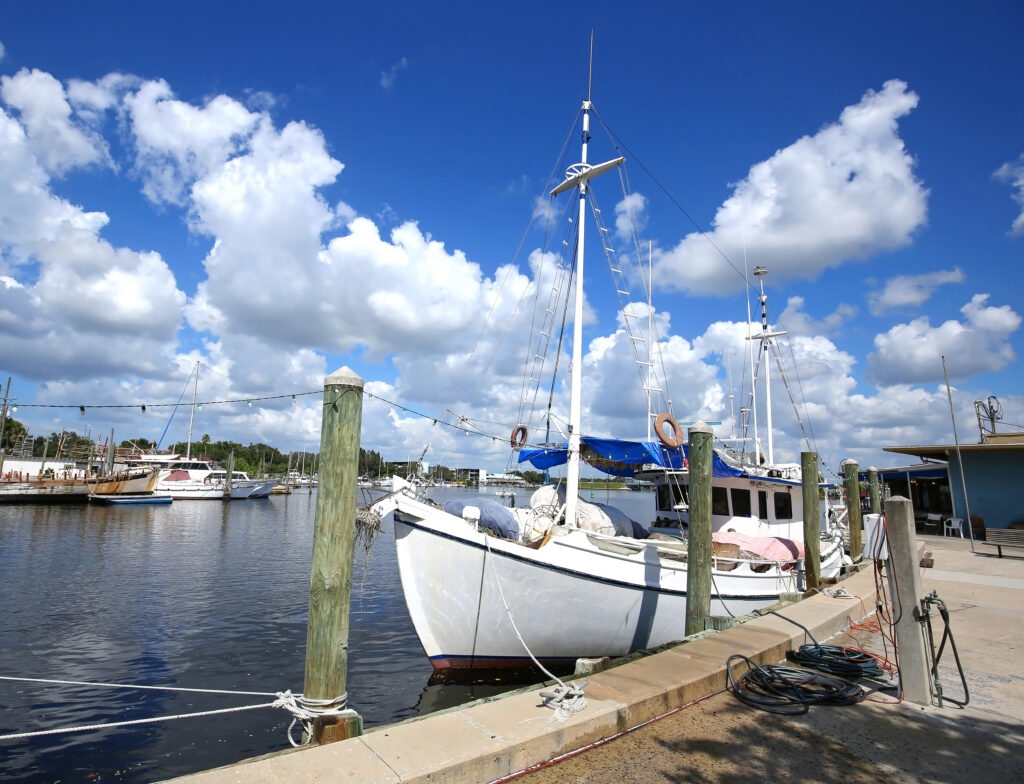
Boating is important for recreation and industry on Lake Michigan.
©Jillian Cain Photography/Shutterstock.com
Lake Michigan is a great destination for boaters and has plenty of space for people to explore and travel, including little beach towns, marinas, historic lighthouses, islands, fishing spots, and other boating things. The lake has many events and festivals that use boats, including events like the Chicago Yacht Club Race to Mackinac, the Grand Haven Coast Guard Festival, and the Milwaukee Air and Water Show.
The diversity of the lake makes it suitable for almost all types of boats. Boats such as sailboats, motorboats, kayaks, and canoes are commonly seen. Also, large barges and shipping boats are often seen on the lake since it is a huge shipping thoroughfare.
Since Lake Michigan is so huge, boaters going out in certain vessels like sailboats should do the proper research to find out if their vessel is suitable for the weather and climate. Often, the lake is treated as an ocean since it’s so large, and the vessels used to travel it need to reflect this.
Camping

There are all sorts of camping opportunities on and around Lake Michigan.
©Steve Schwettman/Shutterstock.com
Lake Michigan has many campgrounds that offer different amenities, activities, and locations for tents and RVs. Some campgrounds are in national or state parks with access to trails, dunes, playgrounds, and even fossil hunting in some places. Other campgrounds are more isolated, especially ones located on islands requiring a boat to access.
Like most campgrounds around the United States, Lake Michigan’s campgrounds vary in availability, rates, and rules depending on the season, hook-ups, and pets. Interested campers should check the details of each campground before booking.
Other Activities
Is boating or camping not your thing? Well, don’t be too worried. Lake Michigan has a LOT more you can do. Some options include:
- Sightseeing around the coast. You can find shops, restaurants, museums, galleries, and festivals in places like Traverse City, South Haven, Grand Haven, Ludington, and Harbor Springs. You can also visit the historic lighthouses that used to (and sometimes still do) guide the ships on the lake.
- Other water activities. Stand-up paddle boarding, kayaking, canoeing, or surfing on Lake Michigan can be a lot of fun. You can rent equipment or join a tour to explore the lake and its wildlife. You can also paddle along the rivers and streams that flow into Lake Michigan.
- Go horseback riding or skiing at Ludington State Park. This park is located between Hamlin Lake and Lake Michigan and offers hiking, biking, fishing, kayaking, and playing on the beach. You can also go horseback riding along the trails or dunes.
- Ride the dunes. There are a few places where there are massive dunes around Lake Michigan, notably the Silver Lake Dunes located within Silver Lake State Park. You can ride dune buggies or even take your own vehicle out on dunes that reach up to 450 feet from the water!
The photo featured at the top of this post is © iStock.com/PeterHermesFurian
Thank you for reading! Have some feedback for us? Contact the AZ Animals editorial team.






